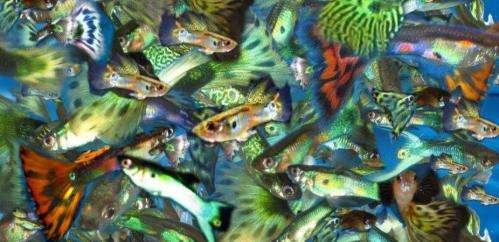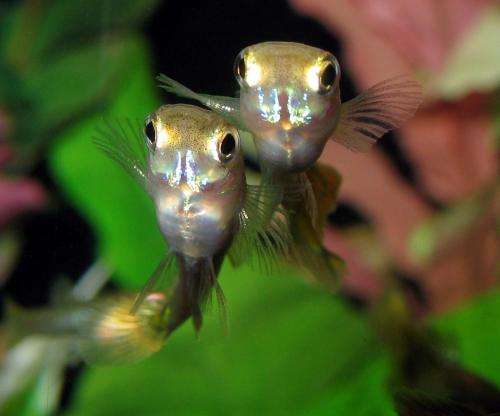Guppies and sexual conflict? It's a genital arms race

(Phys.org) —It's not always easy to tell if a fish is male or female: they look more or less the same. But there are exceptions, such as guppies and, as with humans, guppy genitalia varies in size across the species.
But while male genitalia are necessary to transfer sperm, why should they be so different in shape and length among species? This question has puzzled evolutionary biologists for a long time, and still does. If their job is simply to transfer sperm, why should male genitalia diverge in size or shape?
In a study to understand factors involved in genital evolution, published in Proceedings of the Royal Society B: Biological Sciences on Wednesday, my colleagues and I found guppy genital length is genetic – for females as well as males.
Guppy anatomy
Guppies breed using internal fertilisation (copulation) and as a result are anatomically quite different from the thousands of other fish species that have external fertilisation.
Male guppies have external structures that allow them to transfer sperm into the female's body – notably, a penis-like structure called the gonopodium.
On close inspection, it isn't difficult to spot the "penis" of males, which is used to transfer sperm into the female. We used guppies as a model system to answer questions on the evolution of male genitalia.
Sexual selection is thought to be generally important for genital evolution, and empirical support for this is growing. But the exact mechanisms by which selection acts on male genitalia remain unclear.
Evolutionary biologists have identified a number of factors that may be involved. A certain genital shape might improve a male's ability to win fertilisation when in competition with the sperm of other males, or females might show a preference for males with large genitalia or genitalia of a given shape.
But there can also be an arms-race between female and male genitalia, in which female genitalia evolve to minimise direct or indirect costs imposed by male genitalia.

Disentangling these processes is challenging, but it is especially useful to know whether male and female traits are inherited and how correlated they are, as this helps us to understand the potentiality for evolution to affect genital evolution.
Our research at the Centre for Evolutionary Biology focused on answering two questions:
1.Are male and female genital size and shape inherited from one generation to the next?
2.Are genital traits correlated between males and females?
To tackle those questions my colleagues and I used a quantitative genetic approach that allowed us to explore both aspects simultaneously. But, you might rightly ask, what is a "quantitative genetic approach"?
Despite the fancy definition, understanding how this method works is not difficult and consists of creating families of full- and half-siblings—full-sibs share the same mum and dad, and half-sibs share the same dad but a different mum—and then measuring the length and shape of male and female genitalia.
These data (more than 700 individuals measured) were analysed to determine the extent to which individuals resemble each other due to shared genotypes. In other words, the degree to which genital traits can be inherited.
Our data show that both male and female genital traits can be inherited, and moreover, the length of the male "penis" is genetically correlated with the length of the female genital duct. This means – in the case of the guppy – males with a longer "penis" have sons with a longer "penis" and daughters with a longer genital duct.
What do our results mean?
To answer this question we need to take a small step back, to our previous work in which we showed how males with a longer "penis" are better able to inseminate females when they attempt to copulate without their consent.
Indeed, when forced copulations occur females try to escape from harassing males, so that a longer "penis" evolves to make it easier to inseminate unwilling females.
Females, for their part, may evolve a longer gonoduct as it possibly allows them to retain some control over fertilisation during forced copulations, making difficult for males to deposit sperm closer to the fertilisation site (the ovary), in a sort of "resistance".
Future aims will be to specifically study how, and to what extent, the female genital duct's length can influence the fertilisation outcome when sperm are transferred during forced copulations.
Our findings are in agreement with the idea that the different interests in reproduction between the sexes (what is called sexual conflict) has fuelled the evolution of male genitalia, leading us to think that the corresponding evolution of female genitalia is likely to be a counter-adaptation to the evolution of male genitalia.
That is, the evolution of male genitalia is far away to be simply driven by the aim of transferring sperm, and females have something to say in this respect.
Journal information: Proceedings of the Royal Society B
Source: The Conversation
This story is published courtesy of The Conversation (under Creative Commons-Attribution/No derivatives).

















